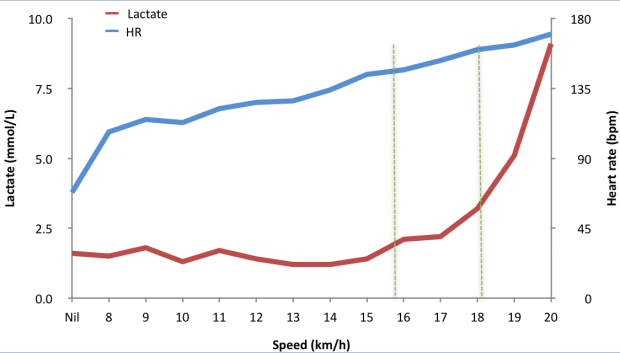Why The Lactate Threshold Is Important For Runners And How Can You Improve It?
Finding out your lactate threshold can help you set your training and racing paces

Every time you exercise, your body produces lactate. And if you’re working hard, this lactate will build up in your blood and cause the burning sensation in your muscles that eventually forces you to stop or reduce your effort significantly.
When running, lactate plays a key role in determining how long you can sustain your efforts. Your lactate threshold pace is what runners call the pace they can maintain for around an hour.
To find out more about lactate threshold, and to discover our own, we went for a physiological assessment with strength and conditioning coach Graham Ferris at Pure Sports Medicine St Paul’s.
What is lactate threshold?
The first thing we learned at our assessment is that there are actually two lactate thresholds.
“The first is your aerobic threshold, where you start to accumulate lactate in your body at a higher rate,” says Ferris. “Lactate is generated as a by-product and then we actually reprocess lactate to give ourselves more energy.
“Our second lactate threshold comes when we end up accumulating too much lactate and we can’t reprocess it. So we get that burning sensation.
“The second lactate threshold is the one you can only sustain for an hour before you need to drop way below it to reprocess. That’ll come at around about 85-90% of your maximum heart rate.”
Get the Coach Newsletter
Sign up for workout ideas, training advice, reviews of the latest gear and more.
Although the first threshold also puts you on the clock, you can sustain that effort for a lot longer.
“You are accumulating lactate, but at a level where you can process it, and you can maintain it for three hours,” says Ferris.
How can knowing your thresholds to help your running?
Perhaps the best use of your lactate threshold is as a guide to what you should aim for in a race, because you have a good idea of how long you can actually sustain your effort and can judge your pace accordingly.
“If you’re aiming to complete a marathon in three hours you know you can stick at your aerobic threshold, that first lactate threshold, because that’s ultimately your race pace,” says Ferris. “And you can work off that if you’re looking to complete it in four or five hours – do you need to be at 90% of your threshold, or 85% of your threshold?”
See related
How do you find out your lactate threshold?
A series of blood tests taken during exercise is the most accurate way to find out your lactate threshold, but some fitness trackers use your heart rate to estimate it.
For our assessment at Pure Sports Medicine we ran intervals of 3½ minutes on a treadmill, increasing the speed with each one. After each interval, Ferris pricked our finger and measured the lactate in our blood, as well as recording our heart rate.
“We get people to run for 3½ minutes because we want to introduce your body to a new pace, and we need you to settle down, because you might be anxious or edgy and your heart rate could spike when you start running,” says Ferris. “That’s why we take the measurement after 3½ minutes of the new pace.
“The body is producing the lactate and as soon as that’s in your blood we can measure that in millimoles per litre of blood.”
Using this data, the two thresholds are determined by looking at increases in the amount of lactate in the blood. On our graph you can see a small but constant increase after the first threshold pace (marked with the first vertical green line), and once we hit the second threshold pace the lactate starts to rise quickly.

The results also show the limitations of using heart rate to work out a person’s lactate threshold. “There is always variability with heart rate,” says Ferris. “The research suggests that the first lactate threshold is 75% [of your max heart rate], but we found with yours that actually it came it at 78%. There are variances based on things like your body type, the type of training you’re doing, and the types of muscle fibres in your body. So it can vary, but roughly we look at 75% and then 85-90% [of your max heart rate] as the two thresholds.”
We have measured our threshold pace with Garmin watches in the past, using a test where you run in a certain heart rate zone for four minutes at a time, and the watch has also recalculated our lactate threshold automatically after runs using a chest strap heart rate monitor. Having done the full test with Pure Sports Medicine, the limits of the test using a fitness tracker are clear – it was around 25 seconds per kilometre out on our lactate threshold pace as found by the blood test. However, you can still use the wrist measurement over time to gauge whether your fitness is going in the right direction.
How do you improve your lactate threshold?
The good news is any kind of training can help, but if you want to improve significantly you need to insert some threshold intervals into your training.
“No matter what training you do, your lactate threshold will become better because you will be working more efficiently,” says Ferris, “but you will want to do repeated efforts just above lactate threshold, and then your recovery just below lactate threshold, so you’re up and down, up and down. Lactate threshold will probably respond better through volume of efforts, so you might do four or five threshold efforts and then rest for the day and go off and do some zone 2 and lighter running on another day. Repeating that more regularly will lead to an increase in lactate threshold.”
A lactate threshold assessment at Pure Sports Medicine costs £150, or you can take it as part of a more in-depth Performance Programme (£375) that consists of four sessions including setting a training plan. Visit the website for more information on booking.

Nick Harris-Fry is a journalist who has been covering health and fitness since 2015. Nick is an avid runner, covering 70-110km a week, which gives him ample opportunity to test a wide range of running shoes and running gear. He is also the chief tester for fitness trackers and running watches, treadmills and exercise bikes, and workout headphones.









